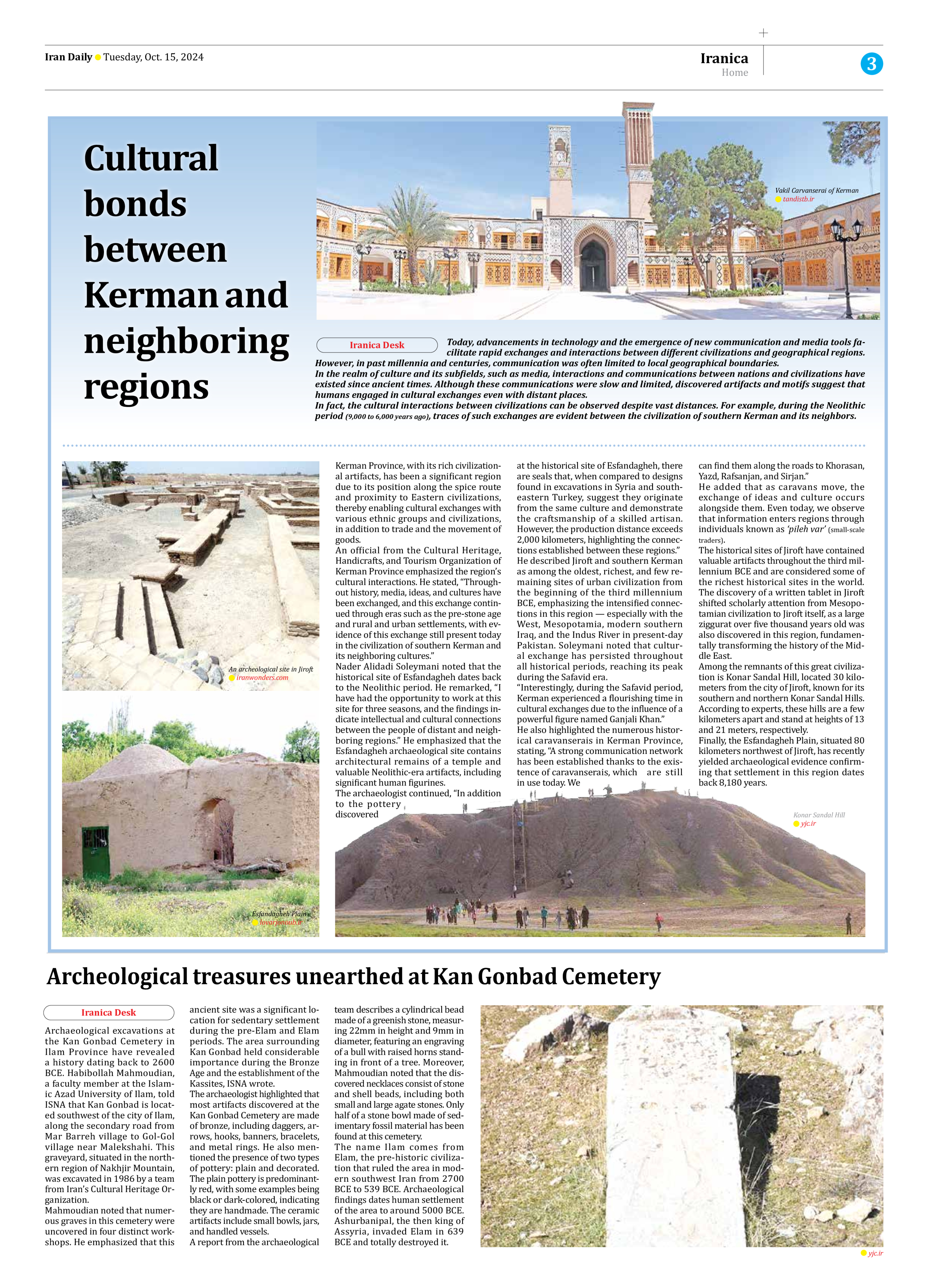
Cultural bonds between Kerman and neighboring regions
Today, advancements in technology and the emergence of new communication and media tools facilitate rapid exchanges and interactions between different civilizations and geographical regions. However, in past millennia and centuries, communication was often limited to local geographical boundaries. In the realm of culture and its subfields, such as media, interactions and communications between nations and civilizations have existed since ancient times. Although these communications were slow and limited, discovered artifacts and motifs suggest that humans engaged in cultural exchanges even with distant places. In fact, the cultural interactions between civilizations can be observed despite vast distances. For example, during the Neolithic period (9,000 to 6,000 years ago), traces of such exchanges are evident between the civilization of southern Kerman and its neighbors.
Kerman Province, with its rich civilizational artifacts, has been a significant region due to its position along the spice route and proximity to Eastern civilizations, thereby enabling cultural exchanges with various ethnic groups and civilizations, in addition to trade and the movement of goods.
An official from the Cultural Heritage, Handicrafts, and Tourism Organization of Kerman Province emphasized the region’s cultural interactions. He stated, “Throughout history, media, ideas, and cultures have been exchanged, and this exchange continued through eras such as the pre-stone age and rural and urban settlements, with evidence of this exchange still present today in the civilization of southern Kerman and its neighboring cultures.”
Nader Alidadi Soleymani noted that the historical site of Esfandagheh dates back to the Neolithic period. He remarked, “I have had the opportunity to work at this site for three seasons, and the findings indicate intellectual and cultural connections between the people of distant and neighboring regions.” He emphasized that the Esfandagheh archaeological site contains architectural remains of a temple and valuable Neolithic-era artifacts, including significant human figurines.
The archaeologist continued, “In addition to the pottery discovered at the historical site of Esfandagheh, there are seals that, when compared to designs found in excavations in Syria and southeastern Turkey, suggest they originate from the same culture and demonstrate the craftsmanship of a skilled artisan. However, the production distance exceeds 2,000 kilometers, highlighting the connections established between these regions.”
He described Jiroft and southern Kerman as among the oldest, richest, and few remaining sites of urban civilization from the beginning of the third millennium BCE, emphasizing the intensified connections in this region — especially with the West, Mesopotamia, modern southern Iraq, and the Indus River in present-day Pakistan. Soleymani noted that cultural exchange has persisted throughout all historical periods, reaching its peak during the Safavid era.
“Interestingly, during the Safavid period, Kerman experienced a flourishing time in cultural exchanges due to the influence of a powerful figure named Ganjali Khan.”
He also highlighted the numerous historical caravanserais in Kerman Province, stating, “A strong communication network has been established thanks to the existence of caravanserais, which are still in use today. We can find them along the roads to Khorasan, Yazd, Rafsanjan, and Sirjan.”
He added that as caravans move, the exchange of ideas and culture occurs alongside them. Even today, we observe that information enters regions through individuals known as ‘pileh var’ (small-scale traders).
The historical sites of Jiroft have contained valuable artifacts throughout the third millennium BCE and are considered some of the richest historical sites in the world. The discovery of a written tablet in Jiroft shifted scholarly attention from Mesopotamian civilization to Jiroft itself, as a large ziggurat over five thousand years old was also discovered in this region, fundamentally transforming the history of the Middle East.
Among the remnants of this great civilization is Konar Sandal Hill, located 30 kilometers from the city of Jiroft, known for its southern and northern Konar Sandal Hills. According to experts, these hills are a few kilometers apart and stand at heights of 13 and 21 meters, respectively.
Finally, the Esfandagheh Plain, situated 80 kilometers northwest of Jiroft, has recently yielded archaeological evidence confirming that settlement in this region dates back 8,180 years.







